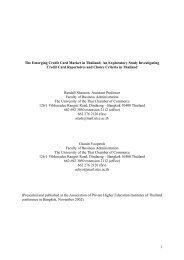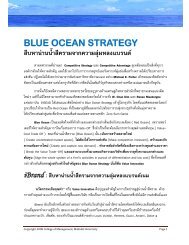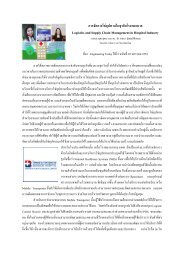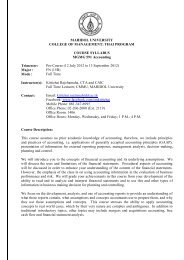Comparative Analysis of Values and Shopping Patterns Among ...
Comparative Analysis of Values and Shopping Patterns Among ...
Comparative Analysis of Values and Shopping Patterns Among ...
You also want an ePaper? Increase the reach of your titles
YUMPU automatically turns print PDFs into web optimized ePapers that Google loves.
Page 1 <strong>of</strong> 11 <br />
ANZMAC 2010<br />
A <strong>Comparative</strong> <strong>Analysis</strong> <strong>of</strong> <strong>Values</strong> <strong>and</strong> <strong>Shopping</strong> <strong>Patterns</strong><br />
<strong>Among</strong> Chinese <strong>and</strong> Thai Mall Shoppers<br />
Yuanfeng Cai, College <strong>of</strong> Management, Mahidol University, bonniecyf@yahoo.com.cn<br />
R<strong>and</strong>all Shannon, College <strong>of</strong> Management, Mahidol University, a.r<strong>and</strong>all@gmail.com<br />
Abstract<br />
Cross-cultural studies have shown few investigations <strong>of</strong> utilitarian versus hedonistic<br />
shopping motives in non-western contexts. This study explores shopping motivations in<br />
two Eastern cultures – Thail<strong>and</strong> <strong>and</strong> China. Based on the literature, it is hypothesized<br />
that Chinese shoppers will be more utilitarian, while Thai shoppers will be more<br />
hedonistic. The research findings support the hypotheses, in that Chinese shoppers do<br />
appear to be driven by more utilitarian motives than Thai shoppers. This means that<br />
while within a larger framework <strong>of</strong> Asian culture, there may be cultural differences<br />
between the two countries, affecting consumer behavior in ways that marketers should be<br />
aware <strong>of</strong>. Future studies might explore more details in terms <strong>of</strong> shopping motives, as<br />
well as explore consumer segmentation to see if more generalizations can be found.<br />
Key words: <strong>Values</strong>, shopping motives, shopping patterns, comparative study,
Page 2 <strong>of</strong> 11 <br />
ANZMAC 2010<br />
A <strong>Comparative</strong> <strong>Analysis</strong> <strong>of</strong> <strong>Values</strong> <strong>and</strong> <strong>Shopping</strong> <strong>Patterns</strong><br />
<strong>Among</strong> Chinese <strong>and</strong> Thai Mall Shoppers<br />
Introduction<br />
The Kingdom <strong>of</strong> Thail<strong>and</strong> has roughly 65 million inhabitants, <strong>and</strong> has been among the<br />
world’s fastest growing markets for modern trade food retailing for the past decade. This<br />
growth has mainly been within the capital, Bangkok, with a population <strong>of</strong> roughly ten<br />
million. Two <strong>of</strong> the five largest malls in the world were built in Bangkok, though they no<br />
longer hold that claim. Smith <strong>and</strong> M<strong>and</strong>hachitara (2000) reported that by the early 1990’s<br />
there were fewer than 50 supermarkets in Bangkok, which has increased to more than<br />
400 in 2010. Deloitte Research’s Thail<strong>and</strong> Investment Review, published in 2006, ranked<br />
Thail<strong>and</strong> third (out <strong>of</strong> nine) for the fifth consecutive year in terms <strong>of</strong> being a key Asian<br />
retail market, behind China <strong>and</strong> Taiwan, with a market value <strong>of</strong> US$21.6 billion. Despite<br />
such rapid development, Thail<strong>and</strong> has been eclipsed by China, which has seen massive<br />
growth in both food retailing <strong>and</strong> shopping mall development. From a few dozen malls<br />
ten years ago (Marqu<strong>and</strong>, 2004), there were roughly 850 by mid 2008. Unfortunately, the<br />
government has reported that more than 20% <strong>of</strong> them have failed, including the world’s<br />
largest mall in 2009 (M<strong>of</strong>com, 2008). Several Thai retailers are exp<strong>and</strong>ing into China,<br />
thus underst<strong>and</strong>ing potential differences in consumer behavior would be beneficial.<br />
It is proposed that cross-cultural testing is considered essential, since most behavioral<br />
theories are rooted in psychology, which, in turn, is heavily bound by cultural values<br />
(Tri<strong>and</strong>is, 1982; Schiffman <strong>and</strong> Kanuk, 1994). Therefore, the present study seeks to<br />
investigate the relationship between personal values <strong>and</strong> mall shopping behavior in a nonwestern<br />
cross-national context. Of particular interest are two questions: how do personal<br />
values influence mall-shopping behavior; <strong>and</strong> how do the value-behavior relationships<br />
differ between countries? This paper focuses on utilitarian/hedonistic shopping motives.<br />
Literature Review & Hypotheses<br />
While a large number <strong>of</strong> motivation studies have been conducted at the store-level, mallrelated<br />
research has been limited. The earliest research on shopping motivation can be<br />
traced back to the late-1940s, where researchers began to explore why people buy at<br />
certain stores (Heidingsfield, 1949). Studies were undertaken to develop shopping<br />
motivation typologies (Stone, 1954; Stephenson <strong>and</strong> Willett, 1969; Darden <strong>and</strong> Ashton,<br />
1975), <strong>and</strong> eventually towards hedonistic versus utilitarian shopping (Tauber 1972, p.<br />
48); Hirschman <strong>and</strong> Holbrook, 1982; Baker et al., 2002; Arnold <strong>and</strong> Reynolds, 2003). <br />
<strong>Shopping</strong> malls were initially conceptualized as a community center where people would<br />
converge for shopping, cultural activity, <strong>and</strong> social interaction (Gruen & Smith, 1960).<br />
Nevertheless, today’s newer versions <strong>of</strong> mega-malls have been designed to go beyond<br />
these basic expectations <strong>and</strong> make the shopping mall a place not just centralized shopping<br />
alternative, but a place that <strong>of</strong>fers more varied choices to serve both functional <strong>and</strong><br />
hedonic needs <strong>of</strong> shoppers (Feinberg et al., 1989; Bloch et al., 1994). Mall shoppers have
Page 3 <strong>of</strong> 11 <br />
been found to visit a mall with diverse motives rather than single functional needs<br />
(Bellenger, et al., 1977; Bellenger <strong>and</strong> Korgaonkar, 1980).<br />
Retail theories <strong>and</strong> research studies have mostly originated from ‘Western’ cultures, <strong>of</strong>ten<br />
focusing on utilitarian shopping motives, such as location convenience, time pressure,<br />
utility, <strong>and</strong> one stop shopping. Most <strong>of</strong> the cross-culture consumer shopping behavior<br />
research has examined differences between westerners <strong>and</strong> Asians (Schutte <strong>and</strong> Ciarlante<br />
1998; Lee 2000; Fuan, et al. 2004). From a Western perspective, it is believed there are<br />
many similarities in consumer behavior within Asian cultural groups, because <strong>of</strong> similar<br />
cultures (Schutte <strong>and</strong> Ciarlante, 1998). However, differences exist within Asian cultural<br />
groups, which are <strong>of</strong>ten not recognized from a Western perspective (Warden, Chen <strong>and</strong><br />
Caskey, 2005). This study aims to contribute to the literature by exploring shopping<br />
motivations among respondents in Eastern cultures.<br />
According to H<strong>of</strong>stede (1980), both Chinese <strong>and</strong> Thai cultures are collectivist in<br />
orientation. Collectivist cultures emphasize the roles <strong>of</strong> people as members <strong>of</strong> group, as<br />
well as the rules <strong>and</strong> principles concerning social shaming <strong>and</strong> social sanctions (H<strong>of</strong>stede,<br />
1991). In addition, it is suggested that collectivist culture possess qualities or values as<br />
prescribed by Confucian principles, including confrontation avoidance, face saving, high<br />
power distance, loyalty, family oriented, thrift, filial piety, <strong>and</strong> respect for authority (Ho,<br />
1987; H<strong>of</strong>stede <strong>and</strong> Bond, 1988; Tri<strong>and</strong>is, 1995; Nakata <strong>and</strong> Sivakumar, 1996; Usunier,<br />
1996; Schwartz, 1999; Carolyn, 2001). Traditional Chinese culture includes<br />
Confucianism, Taoism, Buddhism, <strong>and</strong> a host <strong>of</strong> regional cultures. <strong>Among</strong> them,<br />
Confucianism is considered the most influential. It forms the foundation <strong>of</strong> the Chinese<br />
social <strong>and</strong> cultural value system (Zhang & Harwood, 2004), <strong>and</strong> provides the basis for the<br />
norms <strong>of</strong> Chinese interpersonal behavior (Fung, 1952; Liu, 1997; Pye, 1972; Tu, 1998).<br />
In contrast, about 95 per cent <strong>of</strong> the Thai population is Buddhist, with the Theravada<br />
school being dominant. Ethnic Chinese constitute the most significant minority group in<br />
Thail<strong>and</strong>, making up about 15 per cent <strong>of</strong> the population (CIA World Factbook, 2004).<br />
As a result, Buddhism <strong>and</strong> Confucianism are two schools <strong>of</strong> thought that coexist <strong>and</strong><br />
influence Thai culture. However, it is assumed that the effects <strong>of</strong> Confucianism may be<br />
stronger among the Chinese Thai rather than the Ethnic Thai group, whereas Buddhism<br />
plays a more important role to influence the majority Ethnic Thais.<br />
A comparison between Chinese <strong>and</strong> Thai core cultural values indicates that except ‘mai<br />
pen rai’ (never mind), present oriented <strong>and</strong> ‘sanuk’ (fun) values, the rest <strong>of</strong> the ten Thai<br />
values seem to more or less overlap with the Chinese values. Those three values are<br />
specifically shaped by the Buddhist teachings, thus are represented as values unique to<br />
Thai society (Ovatsatit, 2007). The tendency <strong>of</strong> Thais to seek present or immediate<br />
gratification has been noted by several scholars (Skinner, 1962; Slagter <strong>and</strong> Kerbo,<br />
2000). Ethnic Thais learn to enjoy life <strong>and</strong> to live life in the present <strong>and</strong> face little<br />
pressure to do otherwise. The present oriented value also has been influenced by the<br />
Buddhist concept <strong>of</strong> karma. The value <strong>of</strong> mai pen rai (literally, something doesn’t matter)<br />
suggests that adverse outcomes will get better eventually, so one should not worry about<br />
them, while the value <strong>of</strong> sanuk (literally, fun <strong>and</strong> joy) reflects that Thais tend to view life<br />
as full <strong>of</strong> fun <strong>and</strong> joy <strong>and</strong> not to be taken too seriously, even in the context <strong>of</strong> work
Page 4 <strong>of</strong> 11 <br />
(Warner, 2003). Chetthamrongchai <strong>and</strong> Davies (2000) proposed that hedonic shoppers<br />
score relatively high on present orientation, indicating that they are more concerned with<br />
what is happening now than in the past or in the future. Taken together, it is suggested<br />
that Thai shoppers will be more likely to shop for hedonic reasons.<br />
This implies that while there are many similarities between the cultures, some behavioral<br />
differences may be expected due to differing values. Chinese shoppers are cautious about<br />
spending <strong>and</strong> are less likely to make purchase during their shopping trip (Fuan et al.<br />
2004). The Chinese saying “never make a purchase until you have compared three shops”<br />
(Huo Bi San Jia) reflects the typical searching behavior <strong>of</strong> Chinese consumers, which is<br />
an example <strong>of</strong> how culture can shape consumer behavior <strong>and</strong> lead to differences between<br />
groups. China’s ruling party over the past four decades has also been extolling the virtue<br />
<strong>of</strong> thriftiness <strong>and</strong> discouraging a hedonic life style (which is viewed as self-indulgent <strong>and</strong><br />
wasteful). As a result, it is socially desirable to save money <strong>and</strong> be a meticulous shopper<br />
in China (Wang <strong>and</strong> Rao, 1995). A review <strong>of</strong> literature suggests that Chinese mall<br />
shoppers are more likely to be utilitarian driven (Tse et al., 1989; Tse, 1996; Li et al.,<br />
2004). Utilitarian shoppers tend to view shopping a work/burden rather than fun (Rao<br />
<strong>and</strong> Monroe 1989; Sherry 1990; Nicholls et al. 2000), <strong>and</strong> they are more time conscious<br />
than recreational shoppers (Hansen & Deutscher 1977/78; Bellenger <strong>and</strong> Korgaonkar,<br />
1980; Wilson <strong>and</strong> Holman 1984). Based on the literature review, the following<br />
hypotheses were developed:<br />
H1: Chinese mall shoppers will have more utilitarian shopping motives than Thai<br />
shoppers.<br />
Research Methodology<br />
A self-administered survey was employed for data collection. Self-administered surveys<br />
require comparatively lower cost <strong>and</strong> have a low level <strong>of</strong> intrusiveness (Rundle-Thiele,<br />
2005). Items to measure shopping motives were modified from the scale developed by<br />
Nicholls et al., (2000) <strong>and</strong> the result <strong>of</strong> a focus group. It consisted <strong>of</strong> three items to<br />
measure utilitarian shopping <strong>and</strong> seven items to measure hedonic/social shopping.<br />
Respondents were asked to indicate the extent to which each item described their<br />
shopping motives based on six-point Likert-type scales anchored by not at all descriptive<br />
/very descriptive. A six-point scale was utilized to avoid the common problem <strong>of</strong> Asian<br />
respondents <strong>of</strong>ten answering neutral (Ayer, 1970). Questions were translated <strong>and</strong> back<br />
translated to attain measurement equivalence for constructs (Brislin, 1976; Douglas <strong>and</strong><br />
Craig, 1983; Hui <strong>and</strong> Tri<strong>and</strong>is, 1985).<br />
The sample size for this study was determined with the use <strong>of</strong> multiple statistical<br />
guidelines. The rule <strong>of</strong> thumb suggested by Dillman (1978) <strong>and</strong> Nunnally <strong>and</strong> Bernstein<br />
(1994), requires a minimum cell size <strong>of</strong> 30 for the segmentation variable with the largest<br />
number <strong>of</strong> categories. A sample <strong>of</strong> 300 from each country was deemed to be suitable. The<br />
total number <strong>of</strong> returned questionnaires was 643, with 320 in China, <strong>and</strong> 323 in Thail<strong>and</strong>.
Page 5 <strong>of</strong> 11 <br />
Results <strong>and</strong> Discussion<br />
Table 1. Differences in <strong>Shopping</strong> Motives between Chinese <strong>and</strong> Thai Shoppers<br />
(n China =305, n Thai =308)<br />
China<br />
(n=305)<br />
Thail<strong>and</strong><br />
(n=308)<br />
F Value<br />
Sig.<br />
Mean<br />
Mean<br />
Utilitarian Motives (Cronbach’s alpha = .452)<br />
To get ideas for future purchase 4.43 3.56 61.479 0.00<br />
To make a specific purchase 4.37 4.88 27.319 0.00<br />
To shop in a specific store 3.76 4.51 46.854 0.00<br />
Overall Mean 4.19 4.32<br />
Gr<strong>and</strong> Mean (N=613) 4.25<br />
Hedonic Motives (Cronbach’s alpha = .768)<br />
To hunt for bargains 3.28 4.01 36.233 0.00<br />
To look <strong>and</strong> browse 4.42 4.52 1.033 0.31<br />
To hangout 4.19 4.22 0.1 0.75<br />
To meet <strong>and</strong> spend time together with friends 4.09 4.25 1.695 0.19<br />
Appointment with someone 4.08 4.38 6.584 0.01<br />
To eat 3.61 4.42 54.404 0.00<br />
To escape from routine life 3.37 3.37 0.001 0.98<br />
Overall Mean 3.86 4.17<br />
Gr<strong>and</strong> Mean (N=613) 4.02<br />
It can be seen that Chinese shoppers appear to be comparing or searching for information,<br />
confirming past studies. Thai shoppers were found to be more actively browsing, as well<br />
as making actual purchases. In terms <strong>of</strong> being labeled as utilitarian, the results are mixed,<br />
as the Thai sample gave higher scores on two <strong>of</strong> three variables. However, the Thai<br />
sample scored higher on hedonistic motives, with five <strong>of</strong> them showing statistical<br />
significance. Thail<strong>and</strong> established its first shopping mall in 1967 (Feeny, Vongpatanasin,<br />
Soonsatham, 1996), which is around 20 years earlier than in China. Arguably, the<br />
emergence <strong>of</strong> shopping malls may change consumers’ shopping behavior significantly,
Page 6 <strong>of</strong> 11 <br />
given their unique characteristics, which are structurally different from traditional<br />
shopping venues. A shopping mall is usually characterized with a large amount <strong>of</strong> stores<br />
<strong>and</strong> entertainment facilities <strong>and</strong> presents substantial variety <strong>and</strong> selection <strong>of</strong> products <strong>and</strong><br />
services with pleasant atmosphere (Nicholls et al., 2003). The discrepancy in the mall<br />
development history may imply that Thai shoppers may have shaped themselves as<br />
modern shoppers in the mall to shop for fulfilling diverse needs rather than purchase<br />
alone. It may also be that Thais are more active shoppers, in aggregate, than Chinese,<br />
leading to them giving higher scores for both utilitarian <strong>and</strong> hedonic motivations. The<br />
issue may further be confounded by a consumer’s underlying reason for shopping, as a<br />
shopping trip one day might be viewed as work, while another day a trip to the same<br />
location could be viewed as leisure. It should be noted that the utilitarian construct did<br />
not achieve a high reliability score.<br />
Retailers should be aware that differences in consumer behavior may exist across<br />
cultures, especially when exp<strong>and</strong>ing into markets other than their own. Knowing that a<br />
consumer has more utilitarian motivations may lead to a retailer to adjust the layout <strong>and</strong><br />
flow <strong>of</strong> a mall or merch<strong>and</strong>ise, adjust the amount <strong>of</strong> information or even comparative<br />
information displayed or shared with consumers, or perhaps the importance <strong>of</strong><br />
knowledgeable salespeople.<br />
Future research could further explore hedonistic <strong>and</strong> utilitarian shopping motives <strong>and</strong><br />
actual outcomes, to investigate differences in time <strong>and</strong> money spent, number <strong>of</strong><br />
companions, <strong>and</strong> perhaps price or value consciousness. It is possible that the constructs<br />
used for measuring hedonistic <strong>and</strong> utilitarian motivations may require additional<br />
interpretation. A highly utilitarian shopper may derive hedonistic enjoyment from<br />
comparing prices or obtaining a good deal. It may also be worth exploring potential<br />
differences between groups based on age <strong>and</strong> education, or other psychographic<br />
variables.
Page 7 <strong>of</strong> 11 <br />
References:<br />
Arnold, M.J. & Reynolds, K.E., 2003. Hedonic shopping motivations. Journal <strong>of</strong><br />
Retailing 79(1), 77-95.<br />
Ayer, F., 1970. Quantifying Thai opinions, 181-187 in Dole A. Anderson, Marketing <strong>and</strong><br />
Development, The Thail<strong>and</strong> Experience, Michigan State University.<br />
Bellenger, D.N., Robertson, D.H <strong>and</strong> Greenberg, B.A., 1977. <strong>Shopping</strong> center patronage<br />
motives. Journal <strong>of</strong> Retailing 53, 29-38.<br />
Bellenger, D.N. & Korgaonkar, P.K. (1980). Pr<strong>of</strong>iling the recreational shopper. Journal<br />
<strong>of</strong> Retailing, Vol. 56, No. 3, pp. 77-92.<br />
Bloch, P., Ridgway, N. <strong>and</strong> Dawson, S., 1994. The shopping mall as consumer habitat.<br />
Journal <strong>of</strong> Retailing 70(1), 23-42.<br />
Brislin, Richard W., 1976. <strong>Comparative</strong> research methodology: cross cultural studies.<br />
International Journal <strong>of</strong> Psychology 11, 215-229.<br />
Chetthamrongchai, P. <strong>and</strong> Davies, G., 2000. Segmenting the market for food shoppers<br />
using attitudes to shopping <strong>and</strong> to time. British Food Journal 102 (2), 81-101.<br />
Darden, W.R. & Ashton, D., 1975. Psychographics pr<strong>of</strong>iles <strong>of</strong> patronage preference<br />
groups. Journal <strong>of</strong> Retailing 50, 99-112.<br />
Dillman, D.A., 1978. Mail <strong>and</strong> Telephone Surveys: The Total Design Method. New<br />
York: John Wiley.<br />
Douglas, Susan P. <strong>and</strong> C. Samuel Craig., 1983. International Marketing Research,<br />
Englewood Cliffs, NJ: Prentice Hall.
Page 8 <strong>of</strong> 11 <br />
Feinberg, R.A., Sheffler, B., Meoli J. et Rummel A., 1989. There is something social<br />
happening at the mall. Journal <strong>of</strong> Business <strong>and</strong> Psychology 4, 49-63.<br />
Feeny, A., Vongpatanasin, T., Soonsatham, A., 1996. Retailing inThail<strong>and</strong>. International<br />
Journal <strong>of</strong> Retail & Distribution Management 24(8), 38-44.<br />
Retailing in China 2009: A Market <strong>Analysis</strong>. Access Asia Limited.<br />
http://sjscyxs.m<strong>of</strong>com.gov.cn/sic/_news/html/2008/11/24/1227506915910.html<br />
“Research report on China shopping mall industry in 2008” published by<br />
Zikoo (www.zikoo.com)<br />
Gruen, Victor <strong>and</strong> Larry Smith, 1960. <strong>Shopping</strong> Towns USA: The Planning <strong>of</strong> <strong>Shopping</strong><br />
Centers. New York: Reinhold Publishing Co.<br />
Hansen, R. <strong>and</strong> T. Deutscher, 1977/78. An empirical investigation <strong>of</strong> attribute importance<br />
in retail store selection. Journal <strong>of</strong> Retailing, 53(4) (Winter), 59-64.<br />
Heidingsfield, M., 1949. Why do people shop in downtown department store? Journal <strong>of</strong><br />
Marketing Research 13, 510-12.<br />
Hirschman, E & Holbrook, M., 1982. Hedonic consumption: emerging concepts, methods<br />
<strong>and</strong> propositions. Journal <strong>of</strong> Marketing 46(3), 92-101.<br />
H<strong>of</strong>stede, G., 1980. Culture’s Consequence: National Differences in Thinking <strong>and</strong><br />
Organizing. Sage Press, California.<br />
H<strong>of</strong>stede, G. & Bond, M., 1988. The Confucius Connection: from Cultural Roots to<br />
Economic Growth. Organizational Dynamics 16(4), 4-21.
Page 9 <strong>of</strong> 11 <br />
H<strong>of</strong>stede, Geert, 1991. Cultures <strong>and</strong> Organizations: S<strong>of</strong>tware <strong>of</strong> the Mind: Intercultural<br />
Cooperation <strong>and</strong> its Importance for Survival. Canbridge, Engl<strong>and</strong>: McGraw-Hill.<br />
Hui, C.H. <strong>and</strong> H.C. Tri<strong>and</strong>is., 1985. Measurement in cross-cultural psychology: a review<br />
<strong>and</strong> comparison <strong>of</strong> strategies. Journal <strong>of</strong> cross-cultural psychology 16, June, 131-152.<br />
Li, Fuan; Zhou, Nan; Nicholls, J.A.F; Zhuang, Gujun; Kranendonk, Carl. 2004.<br />
Interlinear or inscription? A comparative study <strong>of</strong> Chinese <strong>and</strong> American mall shoppers’<br />
behavior. The Journal <strong>of</strong> Consumer Marketing 21(1), 51.<br />
Marqu<strong>and</strong>, Robert (November 24, 2004) “China’s Supersized Mall” Retrieved October<br />
22, 2006 from http://www.csmonitor.com/2004/1124/p01s03-woap.html<br />
Nakata, C. & Sivakumar, K., 1996. National culture <strong>and</strong> new product development: an<br />
integrative review. Journal <strong>of</strong> Marketing 60(1), 155-65.<br />
Nicholls, J.A.F., Li, F., M<strong>and</strong>okovic, T., Roslow, S. & Kranendonk, C.J., 2000. US-<br />
Chilean mirrors: shoppers in two countries. Journal <strong>of</strong> Consumer Marketing 17(2), 106-<br />
119.<br />
Nunnally, J. & I. Bernstein, 1994. Psychometric Theory. (3 rd ed.). New York: McGraw-<br />
Hill.<br />
Ovatsatit, Yurapong., 2007. An Exploratory Study <strong>of</strong> Core Cultural <strong>Values</strong>, Ethnicity,<br />
Consumption Attitudes <strong>and</strong> Consumption Intentions in Bangkok, Thail<strong>and</strong>. Dissertation<br />
published, Thammasat Univeristy.<br />
Phillips, H., 1966. The Thai Peasant Personality, Berkeley, CA: University <strong>of</strong> California<br />
Press.<br />
Rao, Akshay R. <strong>and</strong> Kent B. Monroe, 1989. The effect <strong>of</strong> price, br<strong>and</strong> name <strong>and</strong> store<br />
name on buyers’ perceptions <strong>of</strong> product quality: an integrative review. Journal <strong>of</strong><br />
Marketing Research 26 (August), 351-357.
Page 10 <strong>of</strong> 11 <br />
Rundle-Thiele, S., 2005. Loyalty: An Empirical Exploration <strong>of</strong> Theoretical Structure in<br />
Two Service Markets. Unpublished Ph.D. Dissertation, University <strong>of</strong> South Australia.<br />
Schiffman, L.G. <strong>and</strong> Kanuk, L.L., 1994. Consumer behavior. Prentice-Hall, Englewood<br />
Cliffs, NJ.<br />
Schutte, H. & Ciarlante, D., 1998. Consumer Research in Asia, London: Macmillan.<br />
Sherry, John F. Jr., 1990. A Socio-Cultural analysis <strong>of</strong> a midwestern flea market. Journal<br />
<strong>of</strong> Consumer Research 17 (June), 13-30.<br />
Skinner, W. G., 1962. Chinese Society in Thail<strong>and</strong>: An Analytical History. Ithaca, NY:<br />
Cornell University Press.<br />
Slagter, R. & Kerbo, H., 2000. Modern Thail<strong>and</strong>: A Volume in the <strong>Comparative</strong> Societies<br />
Series. New York: McGraw-Hill.<br />
Smith Tasman <strong>and</strong> M<strong>and</strong>hachitara R., 2000. The internationalization <strong>of</strong> retailing in<br />
Thail<strong>and</strong>. In: Ross Davis <strong>and</strong> Toshiyuki Yahagi, editors. Retail investment in<br />
Asia/Pacific: Local responses & public policy issues, The Oxford Institute <strong>of</strong> Retail<br />
Management, 173-190.<br />
Stephenson, R.P. & Willett, R.P., 1969. <strong>Analysis</strong> <strong>of</strong> consumers’ retail patronage<br />
strategies. In Marketing Involvement in Society <strong>and</strong> The Economy, edited by P.R.<br />
Mcdonald, Chicago: American Marketing Association, 316-22.<br />
Stone, G.P., 1954. City shoppers <strong>and</strong> urban identification. American Journal <strong>of</strong> Sociology<br />
60, 36-45.<br />
Tauber, E.M., 1972. Why do people shop? Journal <strong>of</strong> Marketing 36, October, 46-59.
Page 11 <strong>of</strong> 11 <br />
Tri<strong>and</strong>is, H.C., 1982. Dimensions <strong>of</strong> cultural variation as parameters <strong>of</strong> organization<br />
theories. International Studies <strong>of</strong> Management <strong>and</strong> Organization 12(4), 139-69.<br />
Tri<strong>and</strong>is, H. C., 1995. Individualism vs. Collectivism. Boulder, CO: Westview.<br />
Tse, D.K., 1996. Underst<strong>and</strong>ing Chinese people as consumers: past findings <strong>and</strong> future<br />
propositions. In M.H. Bond (Ed.), H<strong>and</strong>book <strong>of</strong> Chinese Psychology, 352-63.<br />
Tse, D.K., Belk, R.W., & Zhou N., 1989. Becoming a consumer society: a longitudinal<br />
<strong>and</strong> cross-cultural content analysis <strong>of</strong> prints ads from Hong Kong, the People’s Republic<br />
<strong>of</strong> China, <strong>and</strong> Taiwan. Journal <strong>of</strong> Consumer Research 15 (March), 457-72.<br />
Usunier, J. C., 1996. Marketing Across Cultures (2 nd ed.). New York: Prentice Hall.<br />
Warden, C., Chen, J., & Caskey, D., 2005. Cultural values <strong>and</strong> communication online:<br />
Chinese <strong>and</strong> Southeast Asian students in a Taiwan international MBA class. Business<br />
Communication Quarterly 68(2), 222-32.<br />
Warner, Malcolm, 2003. Culture <strong>and</strong> Management in Asia. New York: Routledge<br />
Curzon.<br />
Wilson, R.D. <strong>and</strong> R.H. Holman, 1984. Time allocation dimensions <strong>of</strong> shopping Behavior.<br />
Academy <strong>of</strong> Consumer Research 11(1), 29-34.<br />
Zhang, Y.B. & Harwood, J., 2004. Modernization <strong>of</strong> tradition in an age <strong>of</strong> globalization:<br />
cultural values in Chinese television commercials. Journal <strong>of</strong> Communication 54, 156-72.

















